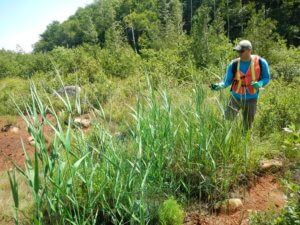 Anyone can help prevent the spread of invasive species, even without leaving their yard.
Anyone can help prevent the spread of invasive species, even without leaving their yard.
That’s the gist of the Adirondack Park Invasive Plant Program’s free webinar “Backyard Invasives—Identification and Management of Terrestrial Invasive Species,” which will run 10- 11:30 a.m. on Wednesday, July 20.
“A lot of invasive species tend to grow on forest edges and roadsides, and some get planted intentionally, making people’s yards an ideal habitat,” said APPIP Terrestrial Invasive Species Coordinator Becca Bernacki.
Invasive species are plants, insects, fish and other animals that are not native to a region and cause ecological, economic or human health harm. They can reproduce quickly, outcompete native vegetation and are often spread by human activity.
Yards not only provide a welcoming habitat for invasives, they’re also heavily travelled upon, which increases the opportunity for plants and seeds to be unintentionally relocated. Mowing and landscaping are two ways unwanted plants can be spread.
And while it isn’t easy to control the spread of invasive species, understanding how to identify and manage them are things anyone can do.
The “Backyard Invasives” course follows a step-by-step outline that is approachable for newbies and invasive-species experts alike. Those looking for pesticide applicator credits can also take the course for 1.5 state pesticide credits in categories 2, 3a, 6a and 9.
“First, we’ll talk about invasive species and why we should care about them,” Bernacki said. “Then we’ll get into pest management, how to develop a goal, and the basics of mechanical and chemical treatment. We’ll also cover five or six specific species to look out for.”
Invasive species are an ever-growing threat to the Adirondacks, and they can cause significant harm to the environment, local economy and human health.
But there is a bright side—a recent study showed that areas where invasive species have been eradicated can recover and be repopulated by native vegetation. Bernacki stressed that professionals working to control the spread of invasives are doing so with limited resources making volunteers, including those who can spot problem species in their own backyards, essential to protecting ecosystems in the Adirondacks.
“Participation in this webinar is important on a broad scale,” Bernacki said. “APPIP it not able to address every infestation across the Park. That’s why a pillar of what we do is empower people to be on the lookout for and manage invasive species.”
To register for “Backyard Invasives—Identification and Management of Terrestrial Invasive Species,” visit https://www.adkinvasives.com/Events/Detail/152.
Read the report “Native Vegetation Reestablishment following herbicide treatment of Japanese knotweed and common reed grass” here: Native Plant Reestablishment Study Final April 2022.pdf (adkinvasives.com)
APIPP’s mission is to protect the Adirondack region from the negative impacts of invasive species. Learn more at www.adkinvasives.com.
The Adirondack Park Invasive Plant Program (APIPP) serves as the Adirondack Partnership for Regional Invasive Species Management (PRISM), one of eight partnerships across New York.
APIPP is hosted by The Adirondack Chapter of The Nature Conservancy and receives financial support from the Environmental Protection Fund administered by New York State Department of Environmental Conservation.